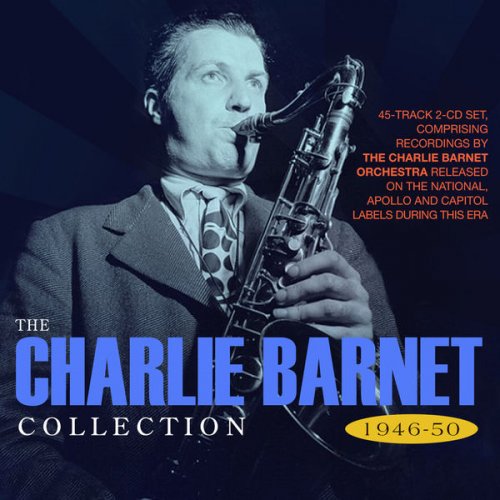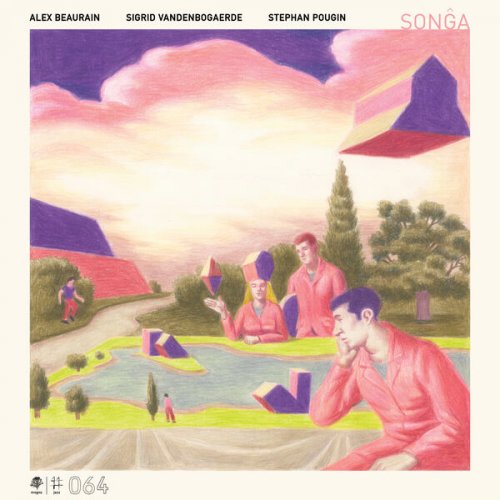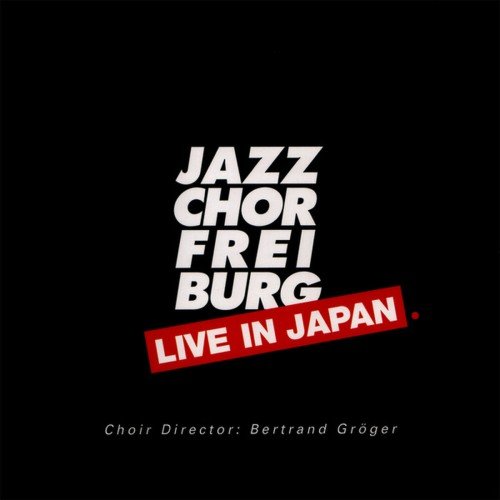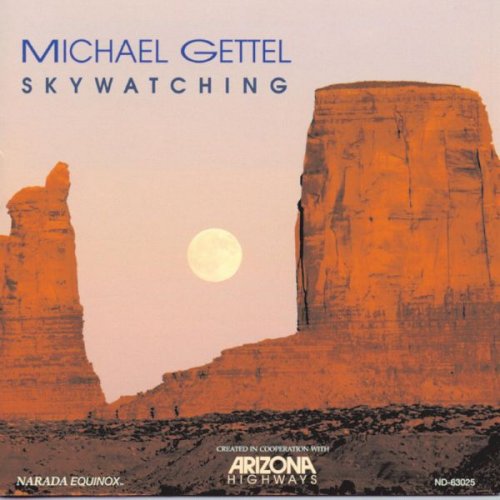Charlie Barnet - Collection 1946-50 (2020)

Artist: Charlie Barnet
Title: Collection 1946-50
Year Of Release: 2020
Label: Acrobat
Genre: Jazz
Quality: FLAC (tracks)
Total Time: 2:19:12
Total Size: 376 MB
WebSite: Album Preview
Tracklist:Title: Collection 1946-50
Year Of Release: 2020
Label: Acrobat
Genre: Jazz
Quality: FLAC (tracks)
Total Time: 2:19:12
Total Size: 376 MB
WebSite: Album Preview
Disc 1
01. The New Redskin Rhumba
02. Cherokee
03. Bunny
04. Atlantic Jump [Atlantic Hop]
05. Caravan
06. At The Darktown Strutters Ball
07. I Cover The Waterfront
08. Sweet Lorraine
09. Deep Purple
10. Jubilee Jump
11. Juice Head Blues
12. Blue Lou
13. East Side, West Side (Sidewalks Of New York)
14. My Old Flame
15. Moods
16. Budandy
17. Charleston Alley
18. Pompton Turnpike
19. Rockin' In Rhythm
20. The Gal From Joe's
21. Southern Fried
22. Little John Ordinary
23. Dirty Rotten Shame Blues
Disc 2
01. Blue Moon
02. Eugipelliv
03. Lonely Street
04. Cu-Ba
05. Easy Living
06. Charlie's Other Aunt
07. Overtime
08. O'Henry
09. Portrait Of Edward Kennedy Ellington Parts 1 & 2
10. Rhapsody In Blue
11. Be-Bop Spoken Here
12. Gloomy Sunday
13. Over The Rainbow
14. All The Things You Are
15. Ill Wind
16. Pan Americana
17. Claude Reigns
18. Really'
19. Spain
20. My Crime
21. Theme For Cynthia
22. I'm A Dreamer, Aren't We All'
Charlie Barnet was unusual in several ways. One of the few jazzmen to be born a millionaire, Barnet was a bit of a playboy throughout his life, ending up with a countless number of ex-wives and anecdotes. He was one of the few white big band leaders of the swing era to openly embrace the music of Duke Ellington (he also greatly admired Count Basie). Barnet was a pioneer in leading integrated bands (as early as 1935). And, although chiefly a tenor saxophonist (where he developed an original sound out of the style of Coleman Hawkins), Barnet was an effective emulator of Johnny Hodges on alto in addition to being virtually the only soprano player (other than Sidney Bechet) in the 1930s and '40s.
And yet Charlie Barnet was only significant in jazz for about a decade (1939-1949). Although his family wanted him to be a lawyer, he was a professional musician by the time he was 16 and ironically in his career made more money than he would have in business. Barnet arrived in New York in 1932 and started leading bands on records the following year, but his career was quite erratic until 1939. Many of Barnet's early records are worthy but some are quite commercial as he attempted to find a niche. Best is a sideman appearance on a 1934 Red Norvo date that also includes Artie Shaw and Teddy Wilson.
In 1939, with the hit recording of "Cherokee" and a very successful run at the Famous Door in New York, Charlie Barnet soon became a household name. In addition to the fine trumpeter Bobby Burnet (who soloed on many of Barnet's Bluebird records), such sidemen as guitarist Bus Etri; drummer Cliff Leeman; singers Lena Horne, Francis Wayne, and Kay Starr; pianist Dodo Marmarosa; clarinetist Buddy DeFranco; guitarist Barney Kessel; and even trumpeter Roy Eldridge spent time with Barnet's bands. Although at the height of his popularity during 1939-1942 (when his orchestra could often play a close imitation of Ellington's), Barnet's recordings for Decca during 1942-1946 were also of great interest with "Skyliner" being a best-seller.
By 1947 Barnet was starting to look toward bop. Clark Terry was his star trumpeter that year, and in 1949 his screaming trumpet section included Maynard Ferguson, Doc Severinsen, Rolf Ericson, and Ray Wetzel. Barnet, however, soon lost interest and near the end of 1949 he broke up his band. Semi-retired throughout the remainder of his life, Charlie Barnet occasionally led swing-oriented big bands during short tours and appearances, making his last recording in 1966. ~ Scott Yanow
And yet Charlie Barnet was only significant in jazz for about a decade (1939-1949). Although his family wanted him to be a lawyer, he was a professional musician by the time he was 16 and ironically in his career made more money than he would have in business. Barnet arrived in New York in 1932 and started leading bands on records the following year, but his career was quite erratic until 1939. Many of Barnet's early records are worthy but some are quite commercial as he attempted to find a niche. Best is a sideman appearance on a 1934 Red Norvo date that also includes Artie Shaw and Teddy Wilson.
In 1939, with the hit recording of "Cherokee" and a very successful run at the Famous Door in New York, Charlie Barnet soon became a household name. In addition to the fine trumpeter Bobby Burnet (who soloed on many of Barnet's Bluebird records), such sidemen as guitarist Bus Etri; drummer Cliff Leeman; singers Lena Horne, Francis Wayne, and Kay Starr; pianist Dodo Marmarosa; clarinetist Buddy DeFranco; guitarist Barney Kessel; and even trumpeter Roy Eldridge spent time with Barnet's bands. Although at the height of his popularity during 1939-1942 (when his orchestra could often play a close imitation of Ellington's), Barnet's recordings for Decca during 1942-1946 were also of great interest with "Skyliner" being a best-seller.
By 1947 Barnet was starting to look toward bop. Clark Terry was his star trumpeter that year, and in 1949 his screaming trumpet section included Maynard Ferguson, Doc Severinsen, Rolf Ericson, and Ray Wetzel. Barnet, however, soon lost interest and near the end of 1949 he broke up his band. Semi-retired throughout the remainder of his life, Charlie Barnet occasionally led swing-oriented big bands during short tours and appearances, making his last recording in 1966. ~ Scott Yanow

![Tomasz Stanko, Polskie Radio - Piece for Diana and Other Ballads (Polish Radio Sessions vol. 1/6) (2025) [Hi-Res] Tomasz Stanko, Polskie Radio - Piece for Diana and Other Ballads (Polish Radio Sessions vol. 1/6) (2025) [Hi-Res]](https://www.dibpic.com/uploads/posts/2025-12/1765797073_cover.jpg)

![Cornelius Claudio Kreusch - Scoop (2025) [Hi-Res] Cornelius Claudio Kreusch - Scoop (2025) [Hi-Res]](https://www.dibpic.com/uploads/posts/2025-12/1765893706_folder.jpg)



![Yasuhiro Usui, Ryoko Ono and Taro Tatsumaki - The House Concert Live Collection, Vol. 55: Yasuhiro Usui (Live at 3rd Floor, Artist House, Daehak-ro, Seoul, 7/12/2015) (2025) [Hi-Res] Yasuhiro Usui, Ryoko Ono and Taro Tatsumaki - The House Concert Live Collection, Vol. 55: Yasuhiro Usui (Live at 3rd Floor, Artist House, Daehak-ro, Seoul, 7/12/2015) (2025) [Hi-Res]](https://www.dibpic.com/uploads/posts/2025-12/1765791289_rchn1y2nh7yfb_600.jpg)
